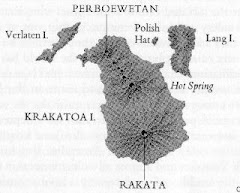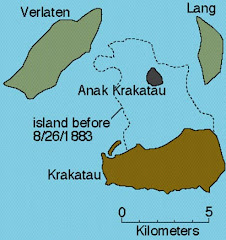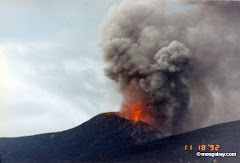Type of Volcano:
Krakatau is a composite stratovolcano that collapsed into a caldera that is now named Anak Krakatau. It formed in a oceanic to continental convergence when the Australia Plate subducted underneath the Eurasia Plate. It is located in Indonesia and lies in the Sunda Strait between Java and Sumatra.
Geography:
Krakatau is located in Indonesia. It lies on the Sunda Strait between Java and Sumatra. It is a convergent continental to continental type of plate boundary where the Australia Plate collides and is subucting underneath the Eurasia Plate. "The island of Krakatua itself lies next to two other islands: Lang and Verlaten. These three islands together are the remains of" Ancient Krakatau. In the 416 A.D. eruption, the majority of the island "collapsed into a 7km long caldera beneath Rakata on Krakatua forming the three present day islands."
Volcano Shape: Ancient Krakatau
Height:
~2000m
Structure:
Cone-like structure (belonging to theSumatra-Java Island Arc) was built up by volcanism over thousands of years, consisting of layers of lava, pumice, and ash
Vents/Craters/Domes:
Lava Dome
- "In volcanology, a lava dome or plug dome is a round-shaped mound in the crater of a volcano that is made because of the built up of molten rock inside the magma chamber for an eruption."
~2000m
Structure:
Cone-like structure (belonging to theSumatra-Java Island Arc) was built up by volcanism over thousands of years, consisting of layers of lava, pumice, and ash
Vents/Craters/Domes:
Lava Dome
- "In volcanology, a lava dome or plug dome is a round-shaped mound in the crater of a volcano that is made because of the built up of molten rock inside the magma chamber for an eruption."
Krakatau's Famous Eruption
Before the erruption of 1883, three major volcanoes existed on the island: Perboewetan, Danan, and Rakata.
August 26-27, 1883
“For three months the people of Batavia had been
intrigued by a series of minor rumblings and puffs of ash from a tiny,
mountainous island in the Sunda Strait, the channel between Java and Sumatra
that linked the Indian Ocean and the Java Sea. At 1 o’ clock on the afternoon of
August 26 their interest was transformed into awe as the island—known as
Krakatau—began to explode in one of the most stupendous eruptions of all time.
Explosion followed upon explosion in ever-increasing intensity. Within one hour
a black cloud 17 miles high loomed over the Sunda Strait. At 5 pm the first of a
series of seismic sea waves, presumably caused by undersea earthquakes
accompanying the eruption, battered the coasts of Java and Sumatra. All through
the night the deafening explosions [equaled to over 21,000 atomic bombs]
continued.”The eruption of Krakatau triggered tsunamis that washed away 165
coastal villages on the Indonesian islands of Java and Sumatra, killing 36,000
people.Krakatau collapsed and sunk 23 square kilometers of the island into the
6km wide caldera later producing Anak Krakatau, also known as Krakatau's Child.
August 26-27, 1883
“For three months the people of Batavia had been
intrigued by a series of minor rumblings and puffs of ash from a tiny,
mountainous island in the Sunda Strait, the channel between Java and Sumatra
that linked the Indian Ocean and the Java Sea. At 1 o’ clock on the afternoon of
August 26 their interest was transformed into awe as the island—known as
Krakatau—began to explode in one of the most stupendous eruptions of all time.
Explosion followed upon explosion in ever-increasing intensity. Within one hour
a black cloud 17 miles high loomed over the Sunda Strait. At 5 pm the first of a
series of seismic sea waves, presumably caused by undersea earthquakes
accompanying the eruption, battered the coasts of Java and Sumatra. All through
the night the deafening explosions [equaled to over 21,000 atomic bombs]
continued.”The eruption of Krakatau triggered tsunamis that washed away 165
coastal villages on the Indonesian islands of Java and Sumatra, killing 36,000
people.Krakatau collapsed and sunk 23 square kilometers of the island into the
6km wide caldera later producing Anak Krakatau, also known as Krakatau's Child.
Fast Facts: Major Eruption
- The eruption was one fo the most catastrophic natural disasters in recorded history
-The effects of the eruption was experienced on a global scale
- Ash from the eruption was carried by winds to places as far away as New York City
-The expolsion was heard more than 3000 miles away
- Tsunami waves were triggered by the eruption and they reached a height of nearly 40 meters above sea level
- "A paroxysmal eruption that occurred at 10:02 blew away the northern two-thirds of the island and was followed by the collapse of the unsupported volcanic chambers of Krakatua forming the huge underwater caldera"
- It had a (Volcanic Explosivity Index) VEI of 6
"Ashfall thicknesses vary greatly within a single VEI category due to differences in eruption and wind conditions. Typically a VEI 6 will produce:
Eruption column height above vent: greater than 80,000 feet
Approximate ash thickness at 10 miles: 10 feet
Approximate ash thickness at 100 miles: 1 foot
Approximate ash thickness at 300 miles: 1 inch
-Total energy released by the 4 main events is equivalent to 200 megatons of TNT
-Amount of ejected material: 21 cubic km
- The left over 1/3 of the island formed Anak Krakatau, or Krakatau's Child
"During the 1883 eruption, proceding events occured:
Central vent eruption
Submarine eruption
Explosive erruption
Pyroclastic flows
Fumarolic Activity
Fatalities
Damage (land, property, etc.)
Mudflow(s) (lahars)
Tsunami (giant sea waves)
Caldera collapse
Evacuation
Debris avalanche(s)
-The effects of the eruption was experienced on a global scale
- Ash from the eruption was carried by winds to places as far away as New York City
-The expolsion was heard more than 3000 miles away
- Tsunami waves were triggered by the eruption and they reached a height of nearly 40 meters above sea level
- "A paroxysmal eruption that occurred at 10:02 blew away the northern two-thirds of the island and was followed by the collapse of the unsupported volcanic chambers of Krakatua forming the huge underwater caldera"
- It had a (Volcanic Explosivity Index) VEI of 6
"Ashfall thicknesses vary greatly within a single VEI category due to differences in eruption and wind conditions. Typically a VEI 6 will produce:
Eruption column height above vent: greater than 80,000 feet
Approximate ash thickness at 10 miles: 10 feet
Approximate ash thickness at 100 miles: 1 foot
Approximate ash thickness at 300 miles: 1 inch
-Total energy released by the 4 main events is equivalent to 200 megatons of TNT
-Amount of ejected material: 21 cubic km
- The left over 1/3 of the island formed Anak Krakatau, or Krakatau's Child
"During the 1883 eruption, proceding events occured:
Central vent eruption
Submarine eruption
Explosive erruption
Pyroclastic flows
Fumarolic Activity
Fatalities
Damage (land, property, etc.)
Mudflow(s) (lahars)
Tsunami (giant sea waves)
Caldera collapse
Evacuation
Debris avalanche(s)
Anak Krakatau (Krakatau's Child)
Currently, the child of Krakatau has reached about 300 m above sea level and has a diameter of 2.52 km and it is still growing to this day.
Eruption Style:
Eruption Style:
explosive: Plinian
Lava Type:
"Highly variable; alternating basaltic to rhyolitic lavas and tephra with an overall andesite composition."
Hazards (lava flows, lahars, pyroclastic flows, debris, etc.)
“Paroxysmal Explosion: As viscous, high-pressure magma explodes from a large, shallow reservoir, it may span the spectrum of volcanism for days on end: A Plinian ash column shoots miles into the stratosphere, glowing avalanches sweep downward, and tens of cubic miles of airborne ejecta bury the countryside. After such eruptions, the entire volcano collapses piecemeal into its empty magma chamber; the resulting is a caldera.”
Vocab:
Tephra- "clastic volcanic material, as scoria, dust, etc., ejected during an eruption."
"tephra." Dictionary.com Unabridged (v 1.1). Random House, Inc. 29 Mar. 2009.http://dictionary.reference.com/browse/tephra>.
Andesite- "a dark grey volcanic rock"
"andesite." WordNet® 3.0. Princeton University. 29 Mar. 2009.http://dictionary.reference.com/browse/andesite>.
Paroxysmal Explosion-
explosive: Plinian
Lava Type:
"Highly variable; alternating basaltic to rhyolitic lavas and tephra with an overall andesite composition."
Hazards (lava flows, lahars, pyroclastic flows, debris, etc.)
“Paroxysmal Explosion: As viscous, high-pressure magma explodes from a large, shallow reservoir, it may span the spectrum of volcanism for days on end: A Plinian ash column shoots miles into the stratosphere, glowing avalanches sweep downward, and tens of cubic miles of airborne ejecta bury the countryside. After such eruptions, the entire volcano collapses piecemeal into its empty magma chamber; the resulting is a caldera.”
Vocab:
Tephra- "clastic volcanic material, as scoria, dust, etc., ejected during an eruption."
"tephra." Dictionary.com Unabridged (v 1.1). Random House, Inc. 29 Mar. 2009.
Andesite- "a dark grey volcanic rock"
"andesite." WordNet® 3.0. Princeton University. 29 Mar. 2009.
Paroxysmal Explosion-
Environmental Dangers/Benefits
Pros of the Eruption:
-recycled life-giving gasses
-created Anak Krakatau
-The ash formed rich soil
Cons of the Eruption:
-mass casualties (aprox. 36,417)
- destroyed 165 villages and towns; 132 seriously damaged
Atmospheric Effects:
"Tephra from the eruption fell as far as 2,500 km downwind in the days following the eruption. However, the finest fragments were propelled high into the stratosphere, spreading outward as a broad cloud across the entire equatorial belt in only two weeks. These particles would remain suspended in the atmosphere for years, propogating farther to the north and south before finally dissipating.
The stratospheric cloud of dust also contained large volumes of sulfur dioxide gas emitted from Krakatau. These gas molecules rapidly combined with water vapor to generate sulfuric acid droplets in the high atmosphere. The resulting veil of acidic areosols and volcanic dust provided an atmospheric shield capable of reflected enough sunlight to cause global temperatures to drop by several degrees. This aerosol-rich veil also generated spectacular optical effects over 70% of the earth's surface. For several years after the 1883 eruption, the earth experienced exotic colors in the sky, halos around the sun and moon, and a spectacular array of anomalous sunsets and sunrises."
-recycled life-giving gasses
-created Anak Krakatau
-The ash formed rich soil
Cons of the Eruption:
-mass casualties (aprox. 36,417)
- destroyed 165 villages and towns; 132 seriously damaged
Atmospheric Effects:
"Tephra from the eruption fell as far as 2,500 km downwind in the days following the eruption. However, the finest fragments were propelled high into the stratosphere, spreading outward as a broad cloud across the entire equatorial belt in only two weeks. These particles would remain suspended in the atmosphere for years, propogating farther to the north and south before finally dissipating.
The stratospheric cloud of dust also contained large volumes of sulfur dioxide gas emitted from Krakatau. These gas molecules rapidly combined with water vapor to generate sulfuric acid droplets in the high atmosphere. The resulting veil of acidic areosols and volcanic dust provided an atmospheric shield capable of reflected enough sunlight to cause global temperatures to drop by several degrees. This aerosol-rich veil also generated spectacular optical effects over 70% of the earth's surface. For several years after the 1883 eruption, the earth experienced exotic colors in the sky, halos around the sun and moon, and a spectacular array of anomalous sunsets and sunrises."
Krakatau Island
Krakau's Cool Websites
http://www.photovolcanica.com/VolcanoInfo/Krakatau/Krakatau.html
http://geont1.lanl.gov/Wohletz/Krakatau.htm
http://www.crystalinks.com/volcanoes.html
http://www.volcano.si.edu/world/volcano.cfm?vnum=0602-00=&volpage=erupt
http://pubs.usgs.gov/gip/volc/eruptions.html
http://www.squidoo.com/krakatoa
http://www.geology.sdsu.edu/how_volcanoes_work/Krakatau.html
http://geont1.lanl.gov/Wohletz/Krakatau.htm
http://www.crystalinks.com/volcanoes.html
http://www.volcano.si.edu/world/volcano.cfm?vnum=0602-00=&volpage=erupt
http://pubs.usgs.gov/gip/volc/eruptions.html
http://www.squidoo.com/krakatoa
http://www.geology.sdsu.edu/how_volcanoes_work/Krakatau.html
E-Z Summary
"Indonesia belongs to one of the most volcanic and seismically active region in the world. There are 128 active volcanoes of which 76 had eruption in historic time. These were occurred in 3 belts which one of is Lesser Sunda Islands where Krakatau is located. The Indonesian Volcano logical Service classified those volcanoes as "class A" volcanoes, of which there 12 in Sumatra Island. One of those is Krakatau. Krakatau is located in South Lampung region in Sunda strait, between Java and Sumatera.
In the early time Krakatau estimated was a volcano with 2000 M in height. The catastrophic eruption destroyed the volcano and remained 3 islands i.e. Rakata, sertung and Panjang. The renewed activity was started at Rakata, and an island of strato volcano was built up with diameter of approximately 5 Km and 800 M high. After its dormancy, next activity was shifted come into existence with the height approximately 456 and 120 M above sea level. In 1883, the 3 summits (Rakata, Danan & Perbuatan) was erupted and leaving a piece of small part of Rakata. The boom of explosion causing tremors and was heard as far as Singapore and Australia. The wave washed everything away around volcano. The volcanic ash was blown in to the atmosphere, as much as 4 cubic miles. In 1927 the new activity was occurred and then Anak Krakatau existed in to being. Now Anak Krakatau has reached 250 M above sea level. Anak Krakatau still active with its gush of steam and smoke, make it spectacular view."
In the early time Krakatau estimated was a volcano with 2000 M in height. The catastrophic eruption destroyed the volcano and remained 3 islands i.e. Rakata, sertung and Panjang. The renewed activity was started at Rakata, and an island of strato volcano was built up with diameter of approximately 5 Km and 800 M high. After its dormancy, next activity was shifted come into existence with the height approximately 456 and 120 M above sea level. In 1883, the 3 summits (Rakata, Danan & Perbuatan) was erupted and leaving a piece of small part of Rakata. The boom of explosion causing tremors and was heard as far as Singapore and Australia. The wave washed everything away around volcano. The volcanic ash was blown in to the atmosphere, as much as 4 cubic miles. In 1927 the new activity was occurred and then Anak Krakatau existed in to being. Now Anak Krakatau has reached 250 M above sea level. Anak Krakatau still active with its gush of steam and smoke, make it spectacular view."
Bibliography
Teacher's Website:
whistlerarenal.blogspot.com
Information From:
Daniels, George. Volcano. Virginia: Time-Life Books Inc, 1982.
Tilling, Robert I. Born of Fire Volcanoes and Igneous Rocks. NJ: Enslow Publishers, Inc., 1991. (Tilling 7,11,48)
"Krakatoa." The Columbia Encyclopedia, Sixth Edition. 2008. Encyclopedia.com. 29 Mar. 2009 http://www.encyclopedia.com/.
Whitney, James A., 1992, Volcano. Grolier Electronic Publisher, Inc..
Simkin, T., and Siebert, L., 1994, Volcanoes of the world: Geoscience Press, Tucson, Arizona, 349 p
Freeman, W.H., Volcanoes, New York, (Freeman 285)
Simkin, T., and Fiske, R.S., 1983, Krakatau 1883: The volcanic eruption and its effects: Smithsonian Institution Press: Washington, D.C., 464 p.
Pictures From:
Bubb, Michael. "The World Explodes, August 27, 1883." Physical Geology 2004 18 Apr 2004 27 Mar 2009 http://www.earlham.edu/~bubbmi/krakatoa.htm.
Carayannis, Carolyn. "Tsunami Generation After the Major Paroxysmal Phase." Disaster Pages 2008 29 Mar 2009 http://www.drgeorgepc.com/Tsunami1883Krakatau.html.
Butler, Rhett. "Anak Krakatau (son of Krakatoa) eruption in Indonesia." 1994 29 Mar 2009 http://www.google.com/imgres?imgurl=http://mongabay.com/images/2005-0726/krakatau_07.jpg&imgrefurl=http://travel.mongabay.com/pix/krakatau_07.html&usg=__nbvjXlXH5AAFykU7cxm22FSVqhs=&h=407&w=600&sz=46&hl=en&start=6&tbnid=ClHKIpk4oLv48M:&tbnh=92&tbnw=135&prev=/images%3Fq%3Dkrakatau%2Beruption%26hl%3Den%26sa%3DG.
whistlerarenal.blogspot.com
Information From:
Daniels, George. Volcano. Virginia: Time-Life Books Inc, 1982.
Tilling, Robert I. Born of Fire Volcanoes and Igneous Rocks. NJ: Enslow Publishers, Inc., 1991. (Tilling 7,11,48)
"Krakatoa." The Columbia Encyclopedia, Sixth Edition. 2008. Encyclopedia.com. 29 Mar. 2009 http://www.encyclopedia.com/.
Whitney, James A., 1992, Volcano. Grolier Electronic Publisher, Inc..
Simkin, T., and Siebert, L., 1994, Volcanoes of the world: Geoscience Press, Tucson, Arizona, 349 p
Freeman, W.H., Volcanoes, New York, (Freeman 285)
Simkin, T., and Fiske, R.S., 1983, Krakatau 1883: The volcanic eruption and its effects: Smithsonian Institution Press: Washington, D.C., 464 p.
Pictures From:
Bubb, Michael. "The World Explodes, August 27, 1883." Physical Geology 2004 18 Apr 2004 27 Mar 2009 http://www.earlham.edu/~bubbmi/krakatoa.htm.
Carayannis, Carolyn. "Tsunami Generation After the Major Paroxysmal Phase." Disaster Pages 2008 29 Mar 2009 http://www.drgeorgepc.com/Tsunami1883Krakatau.html.
Butler, Rhett. "Anak Krakatau (son of Krakatoa) eruption in Indonesia." 1994 29 Mar 2009 http://www.google.com/imgres?imgurl=http://mongabay.com/images/2005-0726/krakatau_07.jpg&imgrefurl=http://travel.mongabay.com/pix/krakatau_07.html&usg=__nbvjXlXH5AAFykU7cxm22FSVqhs=&h=407&w=600&sz=46&hl=en&start=6&tbnid=ClHKIpk4oLv48M:&tbnh=92&tbnw=135&prev=/images%3Fq%3Dkrakatau%2Beruption%26hl%3Den%26sa%3DG.


